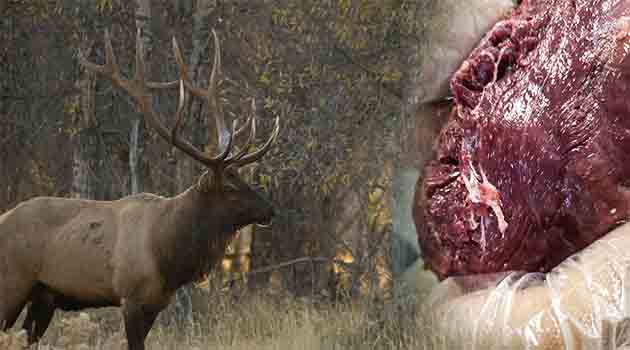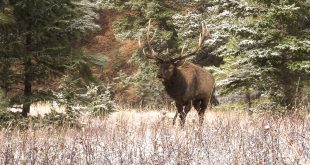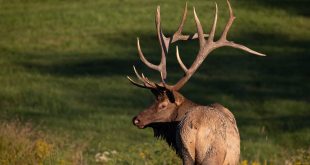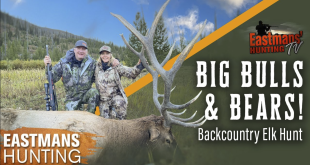
GUEST AUTHOR: Scott Salmon
“Sarcocystosis is a disease caused by a parasite called Sarcocystis. There are numerous species of Sarcocystis. This disease usually affects animals but also can also cause disease in humans.” https://www.cdc.gov/parasites/sarcocystosis/faqs.html
2021 was the year I had planned to use my Wyoming elk points. I had 6 points and planned to put in as partners with my hunting buddy Brian. With a 3 point average we were pretty confident we would draw. Once results came out we saw we were given a general elk tag in Wyoming. Now with tags in our pockets we began to look at units to hunt. We looked at seasons, hunt success, and dates. Once we compiled the data we determined we would do a rifle hunt in October in a unit that had a success in the 30% range. Brian and I began looking at maps, contacting biologists, and researching anyway we could.
As time became close, our excitement grew. We planned on driving into the unit three days before the season opened and scout the areas we had picked out on our maps. With bags packed and gear ready we met up for the 17 hour drive and headed out. We split the drive into two days and hoped to get there early afternoon on day two to set up camp. The next morning we drove to a trailhead and hiked in to scout. Once into the drainage a few miles we started seeing elk and by afternoon we knew this was definitely a good area to be on the opener. That morning we had seen multiple bulls and heard other bulls bulging in the timber.
Day one brought us with excitement and eagerness to get into the drainage we had seen the bulls. We left the trailhead in the light of our headlamps and a few hours before daylight. As daylight hit the hillsides we saw a herd a mile away getting pushed by a herd bull up into a saddle. Brian and I quickly made our way over to the herd to cut them off before they made it into the timber for the day. Using the wind and terrain to our advantage. Brian was able to sneak into 100 yards of the herd bull and place a nice shot on him. After watching the bull go about 70 yards and expire, we quickly grew huge smiles on our faces and gave each other a quick hug and fist bump. With it being 7:45 in the morning we knew we had plenty of time to get the bull quartered, deboned, and ready for the four mile pack out. Each of us knew our part and quickly got to work on the bull.
As we started to debone the bull, Brian’s face portrayed a disgusted look. I looked at him and asked what was wrong? As I approached him I looked down at his knife tip and noticed little white worm looking objects all over in the bull’s meat. Neither of us had ever seen anything like it. In disgust we started looking at all the meat cuts and noticed it was everywhere, running along the muscle fibers. We had no idea what they were but knew we were going to pack all the meat out and start asking questions and doing research.
After getting all the meat out I sent numerous messages and made phone calls to the local biologists and game warden. Brian and I soon found out his bull was full of Sarcocystis (parasite). Not very excited about this and still with lots of questions to be answered, we went back into another drainage to see if we could find a bull for me. That morning we located another herd and I was able to harvest a nice 5×5. We figured we would have one bull with good meat at least giving us some good quality organic meat for our families. As we started breaking down my bull we saw my meat was even worse than Brian’s and were quickly upset and knew we needed to get to the bottom of the parasite and determine if we could even see if we could feed it to our families.
After getting my bull out we spent the next day making phone calls and making a trip to talk to the biologist. Wyoming’s biologist informed us the parasite was like rice breast in ducks and isn’t recommended to be eaten per the info on WGFD website. The biologist told us to pack it all out and take it home. Once we did this, if we didn’t want to eat the meat, we could dispose of it there. I found this disturbing and quickly sought out the local game warden in hopes of a better answer. After a few phone calls the warden contacted us, sent us the info he had on parasites, and gave us the disease specialist in the area’s phone number. We asked the warden if we could get our tags back or points back in hopes of bringing good, clean, organic meat back to our families. The warden told us Wyoming doesn’t do this. Very irritated, Brian and I headed home with a tough decision on whether we were going to feed parasite ridden meat to our families. It turns out the meat can be eaten but the presence of the Sarcocystis requires it to be cooked to 158 degrees.
After 17 hours, many phone calls, and researching the parasite we both decided to discard the elk meat. We knew there was a chance it could affect our families, especially with how prevalent the parasite was in our meat. I know I don’t like my elk cooked well done, other than in burger form.
This decision weighed heavy on our minds and still does today. We do not like waste and enjoy the meat from our hunts. It’s definitely why we hunt. We want to provide for our families. Brian and I both want to educate the hunting community and make them aware of this parasite. We also hope that Wyoming might consider giving tags or points back to other hunters who suffer the same fate.
Editor’s Note: This story was submitted to Eastmans’ Hunting Journals in the hopes it would educate other hunters.
Sources:
https://www.cdc.gov/parasites/sarcocystosis/faqs.html
https://journals.asm.org/doi/10.1128/CMR.17.4.894-902.2004
 Eastmans' Official Blog | Mule Deer, Antelope, Elk Hunting and Bowhunting Magazine | Eastmans' Hunting Journals
Eastmans' Official Blog | Mule Deer, Antelope, Elk Hunting and Bowhunting Magazine | Eastmans' Hunting Journals





Good Article Scott
Sorry for your experience, it needed to be told. I had a friend who experienced
Similar in Canada many moons ago, moose hunting, the animals in a particular area were infected with a parasite. He never did say what he did with the meat lots of meat. This was back in the 70’s.
Panther
Thank you for kind words. Hoping to educate people on this and get word out. Hopefully some residents can help getting things changed to allow people to get there pts back or new tag.
I hunted Colorado and harvested a nice bull. Luckily our friend was there to recognize it had Rice brest all over in every muscle. Packed all the meat out and contacted the local game warden. We discarded ALL the meat. Could not see feeding it to my family. Game warden said he could issue another tag but he would have to confiscate the antlers . Seems they have known about this for some time and we did not see any written info in hunting regs warning hunters on what to look for. If and when the hunting public knows this it could put a big hurt on the income from hunting. Very disappointed.
Todd it’s valuable that you shared this story with the readership. Lots of parasitic disease exist in nature and always have. However based on 2 hunters harvesting 2 animals from separate herds suggests higher prevalence.
I have run across Sarco in ducks 2 times in Mexico and Central America however these birds were always given away. During first incident assumed it was Taenia aka tapeworm.
Having only a 2 week tropical and zoonotic disease class way in the past I did some personal research years ago because I wasn’t sure if I had previously eaten infected meat. I was more concerned about the life phase of the organism. What I mean is visible versus non visible infection of the meat.
The good news is that it was clearly evident to both of you that meat was infected and you took excellent steps in dealing with it, to include avoiding breaking the law with game meat waste crime.
The question I’m asking now is what is the historical prevalence for Sarco? What has changed on the landscape ? The predator prey relationship has a dramatic effect on spread of these type of parasites. Have any new predators that did not exist in that area years ago now exist ?
The other question is will Sarco spread more dramatically and to other grazers ?
Maybe it drives more people away from meat or hunting and no one out there wants that ! No one at all. So awareness is critical.
Seems like Idaho has had some other parasitic outbreaks that didn’t exist for near a century as well and we’re not sure the host or route to increased availability?
As hunters we Need to follow the science and the expert advice similar to what you were given by Wildlife experts and your efforts and handling seem prudent.
Thanks again for sharing.
Will work with Todd and Eastmans to do more articles on the subject. Hoping this is just the start.
Thats messed up! I would have pushed VERY hard to get a re issued tag due to diseased elk. Not your fault the animal had bad meat. Its not like you can go take a meat sample before harvest to make sure its ok. This is pure BS on WDFG part to not allow for a tag re-issue due to tainted diseased meat. Least the would have done is give you your points back! That’s just messed up man, really messed up!
We definitely have. I hope residents help get the voice out there to get this changed. Theres a process that were attempting to submit a letter to wdfw review board to hopefully have a chance to get pts back.
Good to Kevin would do all that pushing !
Kevin is an ignorant person that does not understand the current regulations that are are black and white print – this guy is a typical non-voter and never been involved in rule and law making. A person that goes and looks at the rules after the fact and then whines !
Just like Congress that passes legislative without reading it.
The fact is the way WYGF handled it was by the book. If u don’t like it work with legislators and sportsmans groups to get an amendment or proposition for vote.
So many idiots that don’t understand the nations process but sit back and cry like little girls
Orion, if 2 people travel for an out of state hunt (where they actually cannot vote), harvest elk with the same disease, wouldn’t it stand to reason that the people in charge of making these decisions likely know there is a problem with the herds? Maybe rules do need to be changed legislatively, but a sportsman like approach from WDFG would be to reissue tags for a future hunt. To put that much time, effort and money into a hunt and have your success trumped by not one, but 2 diseased animals sounds like more than just coincidence. C’mon man.
Joe I totally agree.
I retract my statement… but what if it has CWD, at some point Cant reissue tags to everyone for the expanse of disease across the spectrum. CWD, Blue Tongue, Trichinosis, etc !
If u owned cattle and several died of disease would u expect to be compensated ? You as the Hunter decided to take “ that animal” no one forced u to shoot “that animal”. Your choice ur results.
Would it be better for WY to close the season because animals have disease in the herd. Or do we just keep shooting animals until
we harvest a non- infected animal ? Do we get unlimited harvest until we get a “clean” animal
? Is WY not only required to provide us a tag but an animal with no disease ? What if it’s hot and I get meat spoil – is it WY fault or mine for taking that animal and getting spoil due to hot temps ?
What if I shoot a coyote with mange ? It’s on you not the system. Maybe it’s not a stretch for a next season preference but you shoot it you own it no matter the health – WY should not guarantee the health of the animal “You” harvest.
An acknowledgement of the problem would allow people to make a decision based on what is known for the area. Obviously you cannot guarantee every animal is clean, that is not the point being made. This is not a situation where someone is making an unreasonable request, but instead a sportsman who spent alot of time and money on a hunt that produced 2 diseased animals. Had they known this was an issue, they could have made an informed decision. Kudos to Scott for raising awareness. Hopefully this can lead to more conversations and some solutions in the future. Everyone wins in that scenario.
Montana reissues tags, even gives a tag for the next year, if CWD is positive in your animal…Wyoming (and all states) should follow Montana which will gain cooperation with hunters in getting animals tested. Good for you Scott on highlighting this problem!